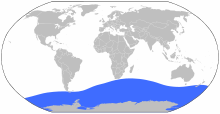Colossal squid
| Colossal squid | |
|---|---|
 |
|
| Size compared to an average human | |
| Scientific classification | |
| Kingdom: | Animalia |
| Phylum: | Mollusca |
| Class: | Cephalopoda |
| Order: | Teuthida |
| Suborder: | Oegopsina |
| Family: | Cranchiidae |
| Subfamily: | Taoniinae |
| Genus: |
Mesonychoteuthis Robson, 1925 |
| Species: | M. hamiltoni |
| Binomial name | |
|
Mesonychoteuthis hamiltoni Robson, 1925 |
|
 |
|
| Global range of M. hamiltoni | |
The colossal squid (Mesonychoteuthis hamiltoni, from Greek mesos (middle), onycho (claw, nail), and teuthis (squid)), sometimes called the Antarctic or giant cranch squid, is believed to be the largest squid species in terms of mass. It is the only known member of the genus Mesonychoteuthis. It is known from only a few specimens, and current estimates put its maximum size at 12–14 m (39–46 ft) long and weighing possibly up to 750 kg (1,650 lb), based on analysis of smaller and immature specimens, making it the largest known invertebrate.
Unlike the giant squid, whose arms and tentacles have only suckers lined with small teeth, the colossal squid's limbs are also equipped with sharp hooks: some swivelling, others three-pointed. Its body is wider and stouter, and therefore heavier, than that of the giant squid. Colossal squid are believed to have longer mantles than the giant squid, but shorter tentacles.
The squid exhibits abyssal gigantism. The beak of M. hamiltoni is the largest known of any squid, and more robust than that of the giant squid. The colossal squid also has the largest eyes documented in the animal kingdom; a partly collapsed specimen measured 27 cm (11 in) in diameter, with a 9 cm (3.5 in) pupil. The eye was estimated to be 30 to 40 cm (12 to 16 in) when the squid was alive.
The squid's known range extends thousands of kilometres northward from Antarctica to southern South America, southern South Africa, and the southern tip of New Zealand, making it primarily an inhabitant of the entire circumantarctic Southern Ocean.
Little is known about the life of this creature, but it is believed to feed on prey such as chaetognatha, large fish such as the Patagonian toothfish, and other squid in the deep ocean using bioluminescence. A recent study by Remeslo, Yakushev and Laptikhovsky revealed that Antarctic toothfish make up a significant part of the colossal squid's diet; of the 8,000 toothfish brought aboard trawlers between 2011 and 2014, 71 showed clear signs of attack by colossal squid. The colossal squid is thought to have a slow metabolic rate, needing only around 30 grams (1.1 oz) of prey daily. Estimates of its energy requirements suggest it is a slow-moving ambush predator, using its large eyes primarily for predator detection rather than active hunting.
...
Wikipedia

